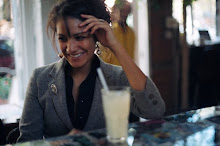I was both very excited and a little skeptical about seeing this film. It's Josh's favorite movie, so of course he's been talking it up to me ever since we started dating. It's not that I don't trust Josh's taste - quite the opposite, actually - but hype is easy to come by in this day and age, and generally the more I hear about something, the less I end up truly enjoying it.
But when the film started rolling, I was immediately captivated. It starts with a few different shots of hill sides and treetops, but instead of giving the viewer a sense of space or the expanse of nature, the effect is purely textural. In that sense, it reminded me of a Jackson Pollock painting. This sets the tone for the whole film - although 95% of the scenes are outdoors, the viewer is only allowed a feeling of closeness... both within the surroundings and to the characters themselves.
Screen Grab from Dersu Uzala
Jackson Pollock's Number One 1948
Kurosawa's delineation of space and expanse is one of the defining factors of Dersu Uzala. He uses many different visual techniques to draw the viewer in and emphasize this sense of closeness. One of these techniques that really stood out to me was his close and sometimes unexpected cropping.
Again and again, Kurosawa used composition to draw the viewer into the image. Here, by setting the horizon so low on the frame, the eye is guided down and into the picture plane. By putting the horizon at essentially eye-level to the theater goer, the viewer is made to feel as if she is on the snow with Dersu and the Captain. This technique really engaged me visually; I was completely pulled into the film. I find that many filmmakers today use plot twists and special effects to captivate an audience and suspend their belief, yet Kurosawa transported me with his lens alone.
Kurosawa's closely cropped composition also appeared in scenes with beautifully arranged figure groups (Something Josh's Uncle Ben has taught me to pay more attention to).
Even though there is a considerable amount of negative space around these figures, this forced sense of depth keeps the eye focused in a very specific area.
There were even a few scenes where the director had cropped a group of soldiers at the ankle - something that any young art school student is taught to be the cardinal sin of composition! But not only does Kurosawa make it work, he uses that framing to emphasize the feeling of closeness that permeates the entire film.
Kurosawa's command of all of the shapes in his frame demonstrated to me that he certainly must have studied the work of master painters. He has complete control of each frame, regardless of how much is going on.
(sorry for the blurry image)
When I saw this scene, the intricate grouping of the figures and the forced sense of depth reminded me of...
Theodore Gericault's The Raft of the Medusa
Kurosawa's command of his medium is just obvious. This film is beautifully calculated and deliberate - it is pure vision. Just when I was starting to believe that film was only good as entertainment, I see a director that truly uses the medium as tool for creating fine art.
Another demonstration of Kurosawa's visual prowess is his use of color throughout the film. Josh explained to me afterwards that Kurosawa and his crew would wait months on end to get one shot with the right light to express a sense of the season. It worked.
And although I'm not sure if Kurosawa intended it, Dersu Uzala also offered something to my fashion obsessed side:
The double breasted coat with a narrow stance, those perfectly worn in boots, that amazing hat - if GQ got a hold of this image, they might have to change their panties.
The entire film presented some great style gems:


















No comments:
Post a Comment